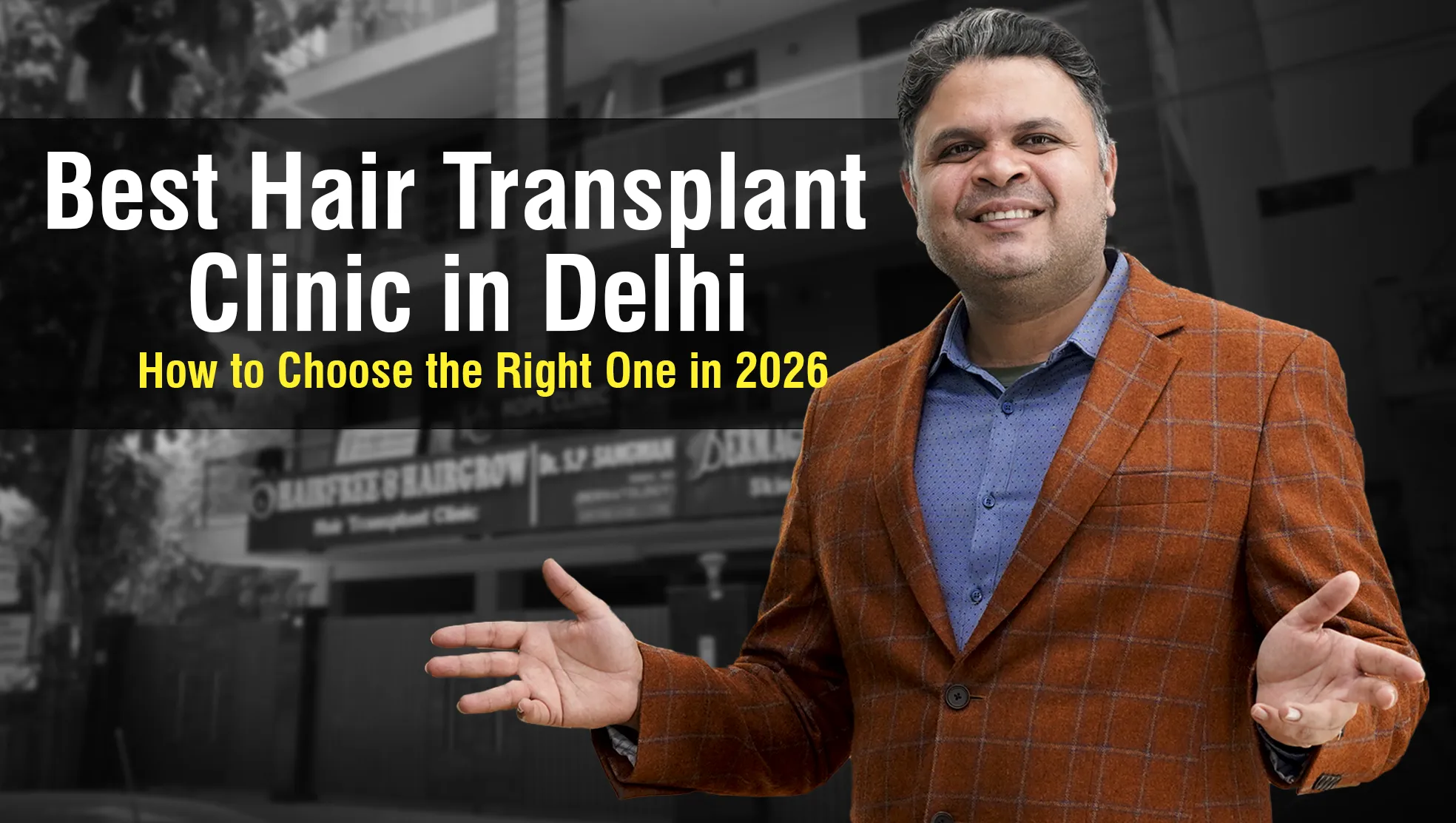If you’ve ever typed “hair transplant before and after” into Google, you’ve probably seen glossy photos, celebrity success stories, and glowing reviews. Hair transplants are often presented as a quick fix for baldness, but the truth is, there’s much more to know before you commit.
In this blog, we’ll uncover the real, lesser-known facts about hair transplants that most brochures and ads leave out. Whether you’re just starting your research or already considering treatment, these insights will help you make an informed decision with confidence.
Why Hair Loss Feels So Personal
Let’s be honest: hair loss is not “just hair.” For many people, it affects confidence, identity, and self-esteem. You might brush it off when friends call you “baldy,” but deep down, it stings.
I remember a patient once saying, “I wasn’t worried about getting old—I was worried about looking old before my time.”
That’s why hair transplants have become one of the most searched cosmetic procedures worldwide. But behind the marketing, there are details no one tells you until now.
1. Your Hairline Needs a Lifetime Plan
A hair transplant isn’t about “filling gaps” alone, it’s about designing a hairline that will look natural for decades.
A poorly planned hairline may look good at 30 but awkward at 50. Skilled surgeons carefully map the angle, density, and placement of each graft to ensure your results age gracefully.
Tip for readers: Don’t just ask “How many grafts?” Ask “How will my hairline look as I age?”
2. It’s Not Just for the Scalp
When people think of transplants, they imagine restoring the top of the head. But modern hair restoration goes beyond that.
- Beard and mustache filling
- Eyebrow transplants
- Scar coverage after accidents or surgery
If you have patchy areas or trauma-related hair loss, transplants can still work for you.
3. More Grafts Don’t Always Mean Better Results
You’ve probably seen clinics advertising “5,000 graft mega sessions.” But here’s the truth: a higher graft number doesn’t automatically mean a better outcome.
What matters most is:
- Survival rate of transplanted follicles
- Placement and distribution of grafts
- Blending with existing hair
A natural look comes from artistry and technique not just numbers.
4. Patience Is Key (Results Take Time)
A transplant is not an instant makeover. In fact, transplanted hair often sheds before it regrows a phase that can feel discouraging.
Here’s the timeline most patients experience:
- 2–3 weeks: Transplanted hairs fall out
- 3–4 months: New growth begins
- 6–9 months: Noticeable changes
- 12–18 months: Full, matured results
If you want a quick fix, a hair transplant is not the answer.
5. Your Donor Area Determines Success
The donor area (usually the back and sides of your head) is the foundation of your transplant. If donor hair is thin, sparse, or weak, your results may be limited.
Some advanced clinics now combine surgery with therapies like:
- Exosome therapy
- PRP (Platelet-Rich Plasma)
- PepFactor treatments
These can improve both donor strength and post-surgery healing.
6. Technique and Technology Matter
One of the most important things no one tells you about hair transplants is that the technique and technology used can make a big difference in your results. The skill of your surgeon is crucial, but equally important is the method chosen for your specific condition. Let’s break down the most common techniques:
1. Follicular Unit Extraction (FUE)
- What it is: FUE is one of the most advanced and popular hair transplant techniques. In this method, individual hair follicles are extracted from the donor area (usually the back of the head) and implanted into the thinning or bald areas.
- Pros:
- Leaves tiny dot-like scars (almost invisible).
- Faster recovery time compared to older methods.
- Looks very natural if done by an experienced surgeon.
- Leaves tiny dot-like scars (almost invisible).
- Best for: People who want less visible scarring, quick healing, and a natural-looking hairline.
2. Follicular Unit Transplantation (FUT)
What it is: Also called the “strip method,” FUT involves removing a strip of scalp from the donor area, then separating it into follicular units to implant in the bald area.
- Pros:
- Allows transplantation of a larger number of grafts in one session.
- Often more affordable compared to FUE.
- Allows transplantation of a larger number of grafts in one session.
- Cons:
- Leaves a linear scar on the donor area.
- Recovery may take longer than FUE.
- Leaves a linear scar on the donor area.
- Best for: Patients who need more grafts and don’t mind a small scar hidden under the hair.
3. Direct Hair Implantation (DHI)
- What it is: A modern variation of FUE where extracted hair follicles are implanted directly using a special implanter pen without creating prior incisions.
- Pros:
- Offers more precision and control over the angle, depth, and direction of implanted hairs.
- Results in a denser and more natural look.
- Faster healing time.
- Offers more precision and control over the angle, depth, and direction of implanted hairs.
- Best for: Patients looking for the latest technique with minimal downtime and maximum density.
4. Platelet-Rich Plasma (PRP) Therapy After Hair Transplant
- What it is: PRP isn’t a transplant method but a supportive treatment often used after surgery. It involves drawing a small amount of your blood, processing it to concentrate the platelets, and injecting it into the scalp.
- Benefits:
- Stimulates faster healing of the scalp.
- Boosts hair graft survival rate.
- Encourages stronger, thicker hair regrowth.
- Stimulates faster healing of the scalp.
- Why it matters: Many surgeons recommend PRP as a follow-up to FUE, FUT, or DHI because it improves long-term results.
The success of a hair transplant doesn’t just depend on “getting it done.” It depends on choosing the right technique for your needs and enhancing the results with supportive treatments like PRP therapy. Always consult a qualified hair restoration surgeon who can guide you on whether FUE, FUT, or DHI is best for you, and whether PRP should be included in your aftercare plan.
7. It’s Not 100% Painless
Most clinics say hair transplants are “painless.” While local anesthesia prevents major discomfort, you may still feel:
- Soreness in the donor area (especially after FUT)
- Mild swelling or tightness
- Temporary scabbing and itching
The good news: recovery is short. Most patients resume light work in 2–3 days.
8. It’s a Serious Financial Investment
Yes, hair transplants can be expensive. But when done correctly, they’re a one-time investment in your confidence.
Cheaper clinics often cut corners overharvesting donor areas, using untrained technicians, or skipping aftercare. The result? Permanent damage.
Instead of asking, “Where’s the cheapest option?” ask, “Where’s the safest and most experienced option?”
9. Lifestyle Still Matters After Surgery
A hair transplant doesn’t make you immune to future hair loss. Stress, poor nutrition, and hormonal imbalances can still affect non-transplanted hair.
Healthy lifestyle choices that support results include:
- Eating a balanced, protein-rich diet
- Reducing stress through sleep and exercise
- Using doctor-recommended hair care products
- Considering maintenance treatments like PRP
Think of it this way: the surgery is step one maintenance is step two.
10. Overharvesting the Donor Area Can Leave Scars
This is one of the most under-discussed risks. Your donor area has limited hair supply. If too many grafts are taken, the area can look visibly thin or scarred.
A responsible surgeon always balances your current needs with long-term preservation.
Why These Facts Aren’t in Brochures
Marketing for hair transplants often shows only the best-case scenarios. Clinics highlight “miracle transformations” but rarely talk about:
- Patience required
- Donor limitations
- Lifestyle responsibilities
By knowing these details upfront, you can avoid disappointment and make choices that give you lasting, natural results.
Who Makes a Good Candidate?
Not everyone qualifies for a hair transplant. The best candidates are those who:
- Have a stable pattern of hair loss (not rapidly progressing)
- Have enough healthy donor hair
- Are in good general health (no uncontrolled diabetes, autoimmune issues, or scalp infections)
- Have realistic expectations (transplants improve coverage, but won’t restore a teenager’s full density)
Patients in their early 20s are often advised to wait since their hair loss may still be evolving.
What the Procedure Really Looks Like (Step by Step)
Here’s what you can expect in simple terms:
- Consultation & Planning
Scalp assessment, photos, and hairline design. - Extraction
Follicles are removed from the donor area using FUT or FUE. - Implantation
Grafts are placed carefully in thinning areas. - Recovery
- Back to work in 2–3 days
- Scabs fall in 7–10 days
- Shedding happens in the first month
- Back to work in 2–3 days
- Results
- Early growth at 3–4 months
- Final outcome after 12–18 months
- Early growth at 3–4 months
Final Thoughts: More Than Just Hair
Hair loss isn’t only about looks it’s about how you feel when you step into a room, meet someone new, or look in the mirror.
A hair transplant, when done right, can restore more than hair it can restore confidence, identity, and peace of mind.
But remember:
- It’s not an instant fix.
- It requires careful planning.
- Choosing the right clinic makes all the difference.
If you’re considering a transplant, don’t rush. Ask questions, research thoroughly, and choose a provider who treats you like a person not just a procedure.
Because in the end, it’s not just about growing hair.
It’s about reclaiming yourself.
FAQs: Things Everyone Wonders About Hair Transplants
1. Will people know I had a transplant?
With advanced techniques like FUE (Follicular Unit Extraction), scarring is minimal and almost invisible to the naked eye. Once the transplanted hair grows in, most people won’t notice you had surgery—unless you choose to tell them.
2. Can I style and color transplanted hair?
Absolutely. Since transplanted hair comes from your own scalp, it behaves just like your natural hair. You can cut, style, curl, straighten, or even color it without any special restrictions once healing is complete.
3. How long do hair transplant results last?
Transplanted hair follicles are typically permanent because they are resistant to balding hormones (DHT). However, your existing non-transplanted hair may continue to thin over time, which is why some people may require maintenance treatments or additional sessions in the future.
4. Is one surgery enough?
For many patients, one session provides the desired density and coverage. But if your hair loss is progressive, you may need touch-ups or a second surgery years later to maintain a natural look.
5. Does a hair transplant look natural?
When done by an experienced surgeon using the latest techniques (FUE, FUT, or DHI), results look completely natural. The transplanted hairline is designed to suit your face shape, age, and natural growth pattern.
Written By
MD (Skin & VD)
Dr. Santpal Sangwan is a trusted specialist in hair restoration with years of experience in advanced techniques. In this blog, he shares key insights about hair transplants, helping patients understand the process, recovery, and long-term results. His goal is to provide clear guidance so you can make confident decisions for your hair journey.
Disclaimer
We’ve made all possible efforts to ensure that the information provided here is accurate, up-to-date and complete, however, it should not be treated as a substitute for professional medical advice, diagnosis or treatment. See Detailed Disclaimers Here.



